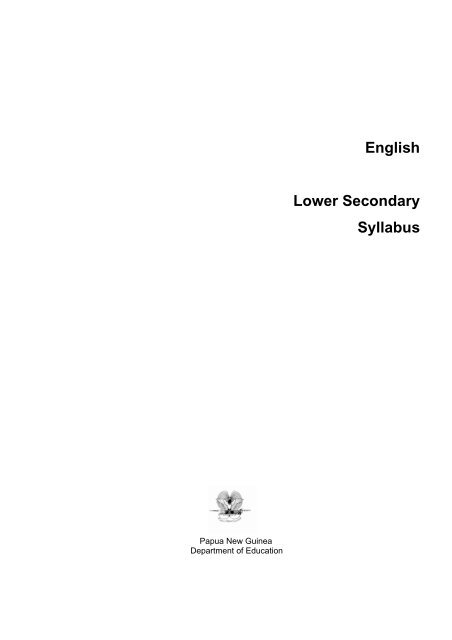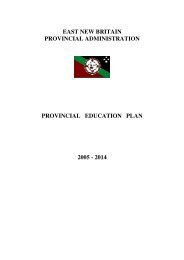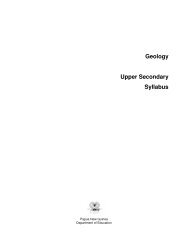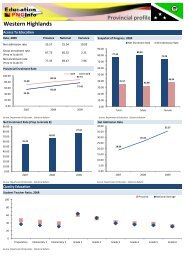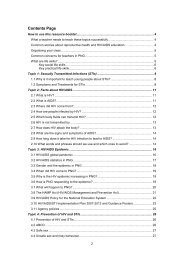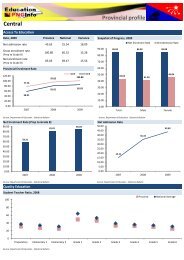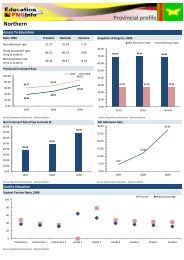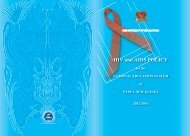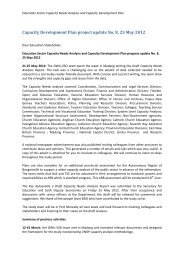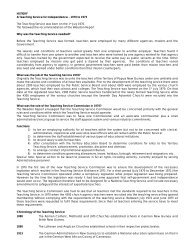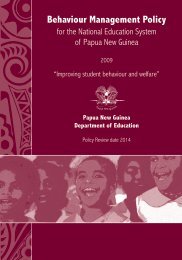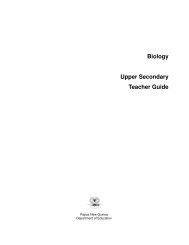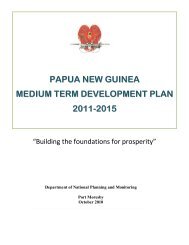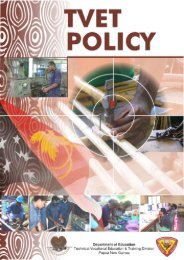English Lower Secondary Syllabus - Department of Education
English Lower Secondary Syllabus - Department of Education
English Lower Secondary Syllabus - Department of Education
Create successful ePaper yourself
Turn your PDF publications into a flip-book with our unique Google optimized e-Paper software.
<strong>English</strong>Issued free to schools by the <strong>Department</strong> <strong>of</strong> <strong>Education</strong>Published in 2007 by the <strong>Department</strong> <strong>of</strong> <strong>Education</strong>, Papua New Guinea© Copyright 2007, <strong>Department</strong> <strong>of</strong> <strong>Education</strong>, Papua New GuineaAll rights reserved. No part <strong>of</strong> this publication may be reproduced, stored in aretrieval system or transmitted by any form or by any means electronic,mechanical, photocopying, recording or otherwise without the prior writtenpermission <strong>of</strong> the publisher.ISBN 9980-935-43-xAcknowledgementsThe <strong>Lower</strong> <strong>Secondary</strong> <strong>English</strong> <strong>Syllabus</strong> was written, edited and formatted bythe Curriculum Development Division <strong>of</strong> the <strong>Department</strong> <strong>of</strong> <strong>Education</strong>. Thedevelopment <strong>of</strong> the syllabus was coordinated by Nancy Minato Waim.Teachers, inspectors, tertiary educators, community members,representatives from non-government organisations and the <strong>English</strong> SubjectAdvisory Committee have assisted in the development <strong>of</strong> this syllabusthrough meetings, workshops and consultations.This document was developed with the support <strong>of</strong> the AustralianGovernment through the Curriculum Reform Implementation Project.ii
<strong>Lower</strong> <strong>Secondary</strong> <strong>Syllabus</strong>ContentsSecretary’s messageivIntroduction 1Rationale 3Curriculum principles 4Aims <strong>of</strong> <strong>English</strong> 10Content overview 11Grade 9 units 17Grade 10 units 33Assessment, examinations and certification 50iii
<strong>English</strong>Secretary’s messageThis syllabus is to be used by teachers to teach <strong>English</strong> to <strong>Lower</strong> <strong>Secondary</strong>students (Grades 9 and 10) throughout Papua New Guinea. This syllabusbuilds upon concepts, <strong>English</strong> skills and attitudes from Upper Primary andlinks to concepts, <strong>English</strong> skills and attitudes in Upper <strong>Secondary</strong>. It providesa sound foundation for further learning.The <strong>Lower</strong> <strong>Secondary</strong> <strong>English</strong> syllabus contributes to integral humandevelopment as it is based on the students’ physical environments, societiesand cultures. It links to the National <strong>Education</strong> Plan’s vision which is thatsecondary education enables students to achieve their individual potential tolead productive lives as members <strong>of</strong> the local, national and internationalcommunity as they undertake a broad range <strong>of</strong> subjects and work relatedactivities that can be used in everyday life.This syllabus provides opportunities for students to explore language in avariety <strong>of</strong> contexts. It is aimed at fostering deeper understanding <strong>of</strong> both the<strong>English</strong> language and the students’ vernacular and through thisunderstanding, the many Papua New Guinean cultural and contemporaryissues that the reform principles are based on.<strong>English</strong> will be learnt in relation to students’ society, local and global culturesand the influences that direct the course <strong>of</strong> these changes. In their exposureto a wide range <strong>of</strong> spoken, written and visual texts from within and outsidethe classroom, students learn how to communicate effectively with othersand make wise and informed decisions about matters to do with family,personal relationships and the wider community. It will encourage studentsto read and write for pleasure and to use language effectively in everydaylife. Thus, the <strong>English</strong> syllabus will be seen as a vehicle to carry through allaspects <strong>of</strong> learning.I commend and approve this syllabus as the <strong>of</strong>ficial curriculum for <strong>English</strong> tobe used in all schools with Grades 9 and 10 students throughout Papua NewGuinea.DR. JOSEPH PAGELIOSecretary for <strong>Education</strong>iv
<strong>Lower</strong> <strong>Secondary</strong> <strong>Syllabus</strong>IntroductionThe National Curriculum Statement states that education in Papua NewGuinea is outcomes based. All <strong>Lower</strong> <strong>Secondary</strong> syllabuses use anoutcomes approach. The <strong>English</strong> syllabus has been designed using learningoutcomes which identify the knowledge, skills, attitudes and values that allstudents achieve or demonstrate by the end <strong>of</strong> Grade 10. It selects theessential knowledge and skills from syllabuses teachers have used in thepast, and incorporates these with developments in <strong>English</strong> to ensure that thesyllabus provides relevant skills and knowledge for students. Language isone <strong>of</strong> the national curriculum learning areas and this <strong>English</strong> syllabus buildson the knowledge and skills students have learnt in primary school.Upper PrimaryLanguageStrandsUpper PrimaryLanguageSubstrands<strong>Lower</strong> <strong>Secondary</strong><strong>English</strong>Strands<strong>Lower</strong> <strong>Secondary</strong><strong>English</strong>Unit organisationSpeaking andlisteningReadingWritingProductionSkills and strategiesContext and textCritical literacySpeaking andlisteningReading and viewingWritingTexts and contextsLanguageSkills and strategiesAssessment is an important component <strong>of</strong> teaching for learning and isintegrated into the teaching and learning activities <strong>of</strong> <strong>English</strong>. Continuousassessment in <strong>English</strong> provides feedback to students and the teacher onstudents' progress towards achievement <strong>of</strong> the learning outcomes. It helpsstudents improve their standards <strong>of</strong> achievement by knowing what they needto do well and where they need to improve. In <strong>English</strong>, teachers will gatherevidence from students’ work during the course <strong>of</strong> the term and use thosecontinuous assessments to improve their teaching and students’ learning.<strong>English</strong> is explored using a range <strong>of</strong> texts. Through critical analysis deepermeanings are drawn and discussed. The learner becomes familiar withfeatures <strong>of</strong> <strong>English</strong> such as spelling, vocabulary, grammar, punctuation,layout, and the important functions <strong>of</strong> the different modes <strong>of</strong>communications. Students understand and use appropriate language tomeaningfully interact with increasingly diverse audiences in their journey aslearners and into adulthood. Students build on prior knowledge, skills, andunderstanding as they progress through to the next grade level.The <strong>English</strong> syllabus is organised using three strands; speaking andlistening, reading and viewing and writing. It involves learning about thedifferent genres used in school and the wider community. Students use anintegrated text-based approach to study a range <strong>of</strong> genres includingliterature, media and everyday texts. Teachers will choose from a range <strong>of</strong>texts suitable for their students to study individually or in groups. As studentslisten to, speak about, read, view and write a range <strong>of</strong> texts, they makemeaning and identify and use the appropriate conventions <strong>of</strong> language.At Grade 9 and 10 emphasis is placed on the development <strong>of</strong> an appropriatelevel <strong>of</strong> competence <strong>of</strong> reading and viewing, writing and speaking andlistening skills. Students undertake a variety <strong>of</strong> activities to improve their1
<strong>English</strong>language skills and these approaches cater for the range <strong>of</strong> needs, interestsand abilities <strong>of</strong> all students and adequately equip them for life after Grade 10either in their communities or onto an academic pathway.<strong>English</strong> is to be timetabled for five periods per week in Grades 9 and 10.2
<strong>Lower</strong> <strong>Secondary</strong> <strong>Syllabus</strong>RationaleLearning <strong>English</strong> is important because it is the medium <strong>of</strong> national andglobal communication. It is the language <strong>of</strong> international communication,business and politics. With more than 800 different languages in Papua NewGuinea, speakers <strong>of</strong> these languages can be drawn together through thelearning and use <strong>of</strong> <strong>English</strong>.Through the study <strong>of</strong> <strong>English</strong>, necessary knowledge, skills, attitudes andvalues will be imparted to the students. Students will learn that <strong>English</strong>transmits cultural perspectives, including gender, class, and ethnicity andenables students to recognise and understand the differences in people.Learning <strong>English</strong> will emphasise the importance <strong>of</strong> contemporary culturalissues which shape meaning and reality and develop positive attitudes to lifeat school and in society to enable students to live successfully with others.Students learn <strong>English</strong> so that they can communicate effectively in a variety<strong>of</strong> situations; in the market place, in the business world and in thetechnological world. The use <strong>of</strong> computers, mobile phones and modernequipment requires <strong>English</strong> reading and viewing skills and an understanding<strong>of</strong> the <strong>English</strong> language. A good command <strong>of</strong> <strong>English</strong> provides students withincreased opportunities for enjoyable leisure activities such as reading orwriting for pleasure and watching television and movies.Potential career opportunities in urban, community or village contexts areincreased for students who have a good command <strong>of</strong> <strong>English</strong>. Fluency in,and an understanding <strong>of</strong> <strong>English</strong> is critical for students in Papua New Guineawho want to go onto higher study or to work in a pr<strong>of</strong>ession.3
<strong>English</strong>Curriculum principlesThe national curriculum principles should influence what students learn andhow teachers teach. These principles relate to our way <strong>of</strong> life, integralhuman development and teaching and learning from the National CurriculumStatement.Our way <strong>of</strong> lifeCultural relevanceCultural relevance focuses on the richness and diversity <strong>of</strong> Papua NewGuinean cultures and languages. Our traditional life is based on a holisticperspective that integrates the past, present and future. Papua NewGuineans are the original inhabitants <strong>of</strong> Papua New Guinea and live insophisticated, organised and self-sufficient societies. Our customs andtraditions constitute a cultural mosaic, rich and diverse, including differentcultural groups. Our customs and traditions are unique. The <strong>English</strong> syllabusenables students to demonstrate an understanding and appreciation <strong>of</strong> thevalues, customs and traditions <strong>of</strong> Papua New Guinea and recognise PapuaNew Guinean languages as forms <strong>of</strong> cultural expression.Maintenance <strong>of</strong> vernacular languageThe <strong>Department</strong> <strong>of</strong> <strong>Education</strong> Language Policy in all Schools states that atthe secondary level, lessons will be conducted in <strong>English</strong>, but teachers canuse opportunities to further develop the students’ oral and written vernacular(or lingua franca) skills, for example when a concept is better explainedusing the vernacular or lingua franca. Students must be encouraged to learnand use <strong>English</strong>, but secondary schools should not discourage freecommunication in vernacular languages that students speak in and out <strong>of</strong>the school grounds.Cultural diversityPapua New Guinea is fortunate to have so many languages and cultures.The diversity <strong>of</strong> our cultures is the source <strong>of</strong> our knowledge, skills, attitudesand Melanesian values. As a multicultural society, we must protect, promoteand respect our many cultures and languages. There are many people fromour own ethnic groups and from other countries with their own cultures, livingand working together in Papua New Guinea. We must ensure that wepromote and share our cultures and maintain our languages and in this way,cultural diversity will be maintained and enjoyed while learning experienceswill be enriched.4
<strong>English</strong><strong>of</strong> gender. The policy aims to prepare students for a satisfying life beyondschool where:• equal, non-violent relationships exist between females and males• rights to personal respect and safety are reflected in everyday life• positive cultural values and individual differences are acknowledged andrespected.There is a need for sensitivity to local cultural practices and values, withrespect to traditional roles for males and females. To implement the policy,teachers have the responsibility to use and promote gender equity practicesin their classrooms and with the wider community. This means teachers:• use teaching and learning strategies that meet the needs and rights <strong>of</strong> allfemale and male students• use gender inclusive language, content, methodology and assessment• respect positive cultural values and challenge unfair cultural practices• respect the contributions <strong>of</strong> men and women to society• promote positive attitudes and behaviours <strong>of</strong> social responsibility,empathy and sensitivity.In <strong>English</strong>, students will be given equal opportunities to participate in allpractical learning and assessment activities regardless <strong>of</strong> gender. In gendersensitive classrooms:• there is a safe, challenging learning environment which is socially andculturally supportive• boys and girls have the right to equal power• students take turns in being the leader and reporter• students share and participate in activities involving different students• students show respect for other students and their contributions• teachers encourage students to challenge stereotyped gender roles.Students with special needsMany students have special needs. Gifted students should be givenopportunities to extend their learning. Students with physical impairmentsneed special support in the classroom. Teachers have a responsibility toensure that the learning needs <strong>of</strong> these students are met. All students areindividuals and all have the right to quality education in order to reach theirfull potential.Teaching and learning<strong>English</strong> is a practical subject and teaching and learning must reflect this.Learning will be done through practical activities; students will learn byspeaking and listening, creative thinking and doing.6
<strong>Lower</strong> <strong>Secondary</strong> <strong>Syllabus</strong>Student-centred learningThe <strong>English</strong> syllabus uses a student-centred approach as a vehicle to guideand facilitate students’ learning. A student-centred approach providesstudents with the opportunity to practice and develop critical and creativethinking, problem solving, decision-making as well as range <strong>of</strong> practical skillsand knowledge.A student centred approach means that teaching and learning strategiesneed to be flexible to cater for individual differences and learning should berelevant and meaningful to the experiences and needs <strong>of</strong> the students. Astudent-centred approach allows teachers to be more flexible in determiningthe most effective ways to help all students achieve the <strong>English</strong> learningoutcomes. Students learn best by being actively active involved in theirlearning through reading and viewing, writing, speaking and listening, andtaking opportunities to be creative.In <strong>English</strong>, students are encouraged to think critically about what they arelearning and to take responsibility for their learning. They learn to teach eachother and to learn from each other, to work cooperatively and to workindividually. They know that learning has a serious purpose. They enjoyusing a wide range <strong>of</strong> texts and developing a wide variety <strong>of</strong> speaking,reading and writing skills. Students learn how to communicate well withothers, how to work things out for themselves and how to get the informationthey need. They become confident through being given the opportunity touse their knowledge and imagination in speaking and writing creatively.Inclusive curriculumAll students are individuals and all have the right to quality education in orderto reach their full potential. An inclusive curriculum uses content, languageand teaching methods that take account <strong>of</strong> all students. All <strong>Lower</strong> <strong>Secondary</strong>syllabuses value the experiences and knowledge <strong>of</strong> all students, regardless<strong>of</strong> gender, ability, geographic location, religious and cultural background, orsocioeconomic status.When interpreting and implementing syllabus learning outcomes teachersmust ensure that the teaching, learning, and assessment activities areinclusive <strong>of</strong> all students. The following statements identify importantrequirements <strong>of</strong> an inclusive curriculum.• All students have fair access to resources such as time spent with theteacher, space in the classroom, books and equipment, outside space.• All students have equal opportunity to participate fully in teaching,learning and assessment activities.• The curriculum includes and addresses the needs and interests <strong>of</strong> allstudents; girls as well as boys, gifted students, students with disabilitiesand students from different cultural and religious backgrounds.• The experiences and knowledge <strong>of</strong> all students are valued by teachersand are reflected in classroom practice.• Teaching and learning methods cater for different learning styles byallowing students opportunities to learn in different ways.• Teachers use a variety <strong>of</strong> assessment methods that give studentsopportunities to demonstrate achievement <strong>of</strong> learning outcomes.7
<strong>English</strong>Teachers have a responsibility to ensure that the curriculum they teach, andthe classroom practices they use, give all students the opportunity to reachtheir full potential.RelevanceThe <strong>English</strong> syllabus should be relevant to the social, spiritual and resourcedevelopment needs <strong>of</strong> a community. A key focus <strong>of</strong> the <strong>English</strong> syllabus is toprovide all students with real life and relevant learning experiences. There isa clear emphasis on the development <strong>of</strong> practical skills and knowledge thatwill ensure students are able to achieve and maintain a sustainable way <strong>of</strong>life beyond their school years. Learning <strong>English</strong> should provide students withopportunities to make connections with, and draw from their cultural,linguistic and everyday knowledge, skills and attitudes and apply this to whatis being learnt in their classrooms. It is essential that students are aware <strong>of</strong>and value community and local knowledge and realise that learning takesplace inside and outside the school context.Most people in Papua New Guinea work in the informal economy. Studentswho leave at the end <strong>of</strong> Grade 10 may need to find work in the informaleconomy. These students, however, will not only need to be skilled to workin the informal economy, but they will also need to be prepared to work inthe formal economy and undertake further education if there areopportunities. To do this they will need to be functionally literate in <strong>English</strong>.Language development across the curriculumLanguage development across the curriculum should be encouragedbecause all subject areas provide meaningful contexts for real purposelearning <strong>of</strong> <strong>English</strong>. Vocabulary and grammar must be explicitly taught inrelevant contexts across the curriculum. Language also provides secondarystudents with opportunities to develop, explore and express their vernacularor lingua franca.Lifelong learningLearning <strong>English</strong> is an important part <strong>of</strong> a student’s education but learningcontinues throughout life. The experiences that students have in <strong>English</strong> arecritical in encouraging them to continue learning. Students know at least onelanguage when they come to school. They may learn others outside schooland continue to learn after they leave school. The curriculum should build onwhat students already know. Learning <strong>English</strong> promotes lifelong learningthrough everyday leisure activities such as watching the news,documentaries and dramas on television or listening to music and songs.IntegrationRelevant and meaningful teaching and learning experiences for <strong>Lower</strong><strong>Secondary</strong> students can best be provided by integrating subjects so thatthey apply to real-life situations. The <strong>English</strong> language is used in all subjectsand assists with purposeful integration.8
<strong>Lower</strong> <strong>Secondary</strong> <strong>Syllabus</strong>SafetyThe <strong>Department</strong> <strong>of</strong> <strong>Education</strong> requires all teachers to have a duty <strong>of</strong> care. Allstudents have a duty to act responsibly and safely at all times. Teachers andstudents must follow safety instructions and procedures at all times. Theschools must observe all safety requirements as instructed by the Secretaryfor <strong>Education</strong>.9
<strong>English</strong>Aims <strong>of</strong> <strong>English</strong>The aim <strong>of</strong> the subject <strong>English</strong> is for all students to be functionally literate bythe end <strong>of</strong> Grade 10.This syllabus aims to develop the following knowledge, skills and attitudes inall students.Knowledge• The way <strong>English</strong> can be used for a variety <strong>of</strong> purposes, audience andcontexts through the use <strong>of</strong> a range <strong>of</strong> texts.• A wide range <strong>of</strong> contexts and texts and the capability to critically analysetexts in relation to personal experiences and the experiences <strong>of</strong> differentsocieties within Papua New Guinea and beyond.Skills• The ability to communicate effectively, appropriately and responsibly in avariety <strong>of</strong> social and functional contexts through the production <strong>of</strong> arange <strong>of</strong> texts.• The ability to speak, listen, read and view, and write with imagination andintellectual competence for a range <strong>of</strong> audiences and contexts.• The ability to use language including mother tongue, lingua franca and<strong>English</strong> to understand, develop and communicate ideas and informationto interact with others in the society.• The ability to organise thinking both logically and in sequence anddemonstrate this in written and spoken form.Attitudes• The ability to demonstrate a deeper understanding and appreciation <strong>of</strong>their own and other cultures, and a commitment to maintaining their owncultures through the competent use <strong>of</strong> language.• The ability to make informed choices about language use in a range <strong>of</strong>social contexts.• The ability to use appropriate functional language skills that will enhancecultural maintenance, social interactions and self-esteem.10
<strong>Lower</strong> <strong>Secondary</strong> <strong>Syllabus</strong>Content overviewBroad learning outcomesThe <strong>English</strong> broad learning outcomes are statements that identify theknowledge, skills, attitudes and values all students achieve or demonstrateat the end <strong>of</strong> Grade 10. The broad learning outcomes for <strong>English</strong> are listedbelow.Students can:1. use and understand <strong>English</strong> structures and forms according to rules andconventions for functional and creative purposes2. communicate ideas and information in a variety <strong>of</strong> ways (written, oral,and visual) according to purpose, audience and context3. respond to and analyse a variety <strong>of</strong> texts on a range <strong>of</strong> issues fromPapua New Guinea and the world4. respond to and value different cultures through the study <strong>of</strong> literature andother texts.StrandsThe study <strong>of</strong> <strong>English</strong> is described in the following three strands:• speaking and listening• reading and viewing• writing.<strong>English</strong> is best taught through integration <strong>of</strong> all the above strands.Speaking and listeningThe speaking and listening strand deals with the ability to speak with clarity,fluency and appropriateness. Students listen for specific purposes such asidentifying key ideas, taking note <strong>of</strong> information and summarising mainpoints. In their local surroundings and the global community, they learn tolisten and speak about more challenging ideas and issues. This enablesthem to interact in both formal and informal situations such as speaking inpublic and performing in plays, participating in interviews, and inquiring andnegotiating in daily life routines. In speaking and listening, students learn to:• interpret a range <strong>of</strong> spoken texts• participate in formal and informal dialogues• compose and present spoken texts for a range <strong>of</strong> contexts, purposes andaudiences• identify and use appropriate <strong>English</strong> for spoken texts• use digital and electronic technologies where appropriate.11
<strong>English</strong>Reading and viewingIn the reading and viewing strand students develop the ability to read withclarity and understanding and are able to demonstrate this in a wide range <strong>of</strong>situations. Their knowledge about the world around them can be broadenedas they read and view a diverse range <strong>of</strong> texts. Reading these texts willenable them to gain information about current critical issues such asHIV/AIDS, to expand on personal experiences and to gain enjoyment. Asthey read and view a variety <strong>of</strong> texts they learn to:• engage with a range <strong>of</strong> written and visual texts for different purposes• interpret and respond to different texts• demonstrate critical understanding <strong>of</strong> texts• identify the language appropriate to the kind <strong>of</strong> texts• use information and communication technologies and critically analyseelectronic information for accuracy and quality.WritingStudents can demonstrate competency when they can compose a range <strong>of</strong>texts to communicate thoughts, feelings ideas and opinions with a range <strong>of</strong>audiences within the school, community and beyond. They learn to write fordifferent purposes so as to inform, persuade, speculate, reflect andhypothesise. In writing the students learn to:• consider the purpose for their writing• compose a range <strong>of</strong> texts• demonstrate critical understanding <strong>of</strong> the contexts and audiences <strong>of</strong> theirtexts• use appropriate language for the kind <strong>of</strong> text or genres• make sense and meaning <strong>of</strong> their texts to a range <strong>of</strong> situations andaudiences.The scope and sequence <strong>of</strong> unit organisationThe <strong>English</strong> syllabus is organised into units using the three strands; readingand viewing, writing and listening and speaking. In these units students willuse a range <strong>of</strong> texts and show understanding <strong>of</strong> these texts by exploring thecontexts in which they are produced and critically analysing differentperspectives. The study <strong>of</strong> <strong>English</strong> is important for making meaning <strong>of</strong> texts.As students produce and engage with these texts they develop multiplestrategies as readers, viewers, writers, listeners and speakers.Texts and contextsThe use <strong>of</strong> a variety <strong>of</strong> texts will enable students to engage with, produce,and respond to a range <strong>of</strong> situations. The choice <strong>of</strong> texts will be based on anegotiated learning approach by both the teacher and the students. Textsrefer to the art <strong>of</strong> communication in language that may take the form <strong>of</strong>12
<strong>Lower</strong> <strong>Secondary</strong> <strong>Syllabus</strong>spoken, written, visual, or a combination <strong>of</strong> different modes in a range <strong>of</strong>different contexts.The different contexts include:• the situational contexts in which a text and its language is constructed indifferent ways to suit the purpose, audience and subject in the threestrands• the socio-cultural context which will enable students to reflect on adiverse range <strong>of</strong> values, beliefs, behaviours and ways <strong>of</strong> thinking anddoing things.In the <strong>English</strong> syllabus, a range <strong>of</strong> texts are studied and used to facilitatelearning <strong>of</strong> formal <strong>English</strong> structure and forms. The ranges <strong>of</strong> texts listed areall possibilities (see page 15). Teachers and students select from the type <strong>of</strong>texts available at the school. In their exposure to a wide range <strong>of</strong> text-basedlearning, students develop a sense <strong>of</strong> identity in being part <strong>of</strong> a larger societywith others in their immediate environment.With this perspective, their engagement with literature, media and everydaytexts will facilitate learning and communicating within <strong>English</strong> and otherlanguages that are also important. Using these texts to share, interpret,convey meaning and make sense <strong>of</strong> their cultural societies, the skills tospeak, read, view, think and write will be sharpened.Literature texts enable students to develop and understand cultural values.They also enhance learning to respect and appreciate those values that aredifferent to their own. Works <strong>of</strong> literature enable students to understand andexplore values in a society such as Papua New Guinea. Students build acritical awareness <strong>of</strong> the powerful influence <strong>of</strong> popular cultures that are apart <strong>of</strong> the modern global society <strong>of</strong> which Papua New Guinea is a part.The study and use <strong>of</strong> media texts are critical in today’s society. Studentsneed to identify and respond to different forms <strong>of</strong> media texts that areavailable in the modern world.All texts are part <strong>of</strong> people’s daily lives and are critical for effective dailyengagement. The development <strong>of</strong> critical literacy will be encouraged instudents as they are exposed to a variety <strong>of</strong> texts. Critical literacy willpresent knowledge as a social construction linked to norms and values. Itenables the students to understand the deeper meanings <strong>of</strong> texts byequipping them with skills to analyse the validity and source <strong>of</strong> information. Itis important that students know how texts work, how they manipulatereaders, and how they position them to read or interpret situations inparticular ways. They need the tools to carry out analysis. They need to askwhy a text is produced, what the message is and what version <strong>of</strong> reality itpresents. Critical literacy therefore, presents itself as an important area tocover in <strong>English</strong>.As students leave school, they form local and the global communities whichleads to the practical use <strong>of</strong> the range <strong>of</strong> texts that they have covered in their<strong>English</strong> learning in Grades 9 and 10. In their endeavours to go beyondGrade 10 pursuing an academic career or one that will lead to theircommunities, texts in <strong>English</strong> learning and communication in speaking,reading, viewing and writing can equip students to be functional and literatepeople in society.13
<strong>English</strong>LanguageUnderstanding aspects <strong>of</strong> language is important to enable students todiscover new ideas and information and to convey and receive information.Language shapes meaning and creates reality in a whole range <strong>of</strong> contexts.Students understanding <strong>of</strong> how language is constructed and used in differentcontexts and different cultural societies can enable them to learn aboutpeople and their complexity. This will enable them to find their own place inthis complex world and confidently apply this knowledge.In the speaking, listening and reading and viewing strands, <strong>English</strong> is furtherexplored using a range <strong>of</strong> texts. Through critical analysis deeper meaningscan be drawn and discussed. The learner is able to become familiar withfeatures <strong>of</strong> <strong>English</strong> such as spelling, layout, punctuation and the importantfunctions <strong>of</strong> the different modes <strong>of</strong> communication. Students understand anduse appropriate language to meaningfully interact with increasingly diverseaudiences at school and into adulthood.Skills and strategiesA range <strong>of</strong> skills and strategies can be used to explore different ideasthrough the texts that students study and produce. The range <strong>of</strong> strategiesmay include skimming, predictions prior to reading and brainstorming <strong>of</strong>ideas, use <strong>of</strong> questioning and props to elicit information, and discussions todiscover other peoples’ point <strong>of</strong> view. Students can develop many ways toexpress ideas as they recognise and explore the function and power <strong>of</strong>language.14
<strong>Lower</strong> <strong>Secondary</strong> <strong>Syllabus</strong>Unit learning outcomes mapped against broad learning outcomesBroad learningoutcomes1Use and understand<strong>English</strong> structuresand forms accordingto rules andconventions forfunctional andcreative purposes2Communicate ideasand information in avariety <strong>of</strong> ways(written, oral, andvisual) according topurpose, audienceand context3Respond to andanalyse a variety <strong>of</strong>texts on a range <strong>of</strong>issues from PapuaNew Guinea and theworld4Respond to andvalue differentcultures through thestudy <strong>of</strong> literatureand other textsUnit 9.1Unit 9.29.1.1 create simple written and oral textsdemonstrating control <strong>of</strong> language whencommunicating with familiar audiences9.2.1 create written and oral texts that arecommon in the world <strong>of</strong> work usingappropriate structures and language features9.1.2 read, view, listen to and discuss textsabout, or used in, everyday home andleisure activities in the wider Papua NewGuinean community9.2.2 read, view, listen to and discussaspects <strong>of</strong> the world <strong>of</strong> work in a range <strong>of</strong>texts from Papua New Guinea contexts andother sourcesUnit 9.39.3.1 create narrative texts based on PapuaNew Guinean experiences using appropriatestructures and language features9.3.2 read, view, listen to and discuss arange <strong>of</strong> narrative texts from Papua NewGuinea and beyondUnit 9.49.4.1 create written and oral texts thatinform, influence or persuade adopting thestructure and language features <strong>of</strong> the genre9.4.2 read, view, listen to and discuss arange texts designed to inform, influenceand/or persuade others.Unit 10.110.1.1 create written and oral texts aboutissues relating to the home and socialenvironments using language appropriate tocontexts and purpose.10.1.2 recognise and use literacy strategiesto develop intercultural competence forunderstanding, responding to, and initiatingeffective communicationUnit 10.210.2.1 create written and oral texts todemonstrate views related to different types<strong>of</strong> formal and informal work available in thecommunity10.2.2 read, view , listen to and respond to arange <strong>of</strong> complex texts used in theworkplaceUnit 10.310.3.1 create sustained written and oraltexts which apply knowledge <strong>of</strong> languagefeatures for a range <strong>of</strong> purposes and culturalcontexts10.3.2 read, view, listen to and respond torange <strong>of</strong> complex texts about Papua NewGuinea and beyond to enhance perception <strong>of</strong>their broadening world and their relationshipwith it.Unit 10.410.4.1 create sustained written and oraltexts that inform, influence or persuadeadopting the conventions <strong>of</strong> a range <strong>of</strong>genres.10.4.2 read, view, listen to and respondcritically to a range <strong>of</strong> texts designed toinform, influence and/or persuade others.15
<strong>English</strong>Grade 9 and Grade 10Range <strong>of</strong> textsLiteratureLiterary texts are characterised by the aesthetic use <strong>of</strong> language and the imagination to shape, explore,reproduce understandings about, reflect on, represent, and speculate about human experience throughthe construction <strong>of</strong> real and imagined (including virtual) worlds. Literary texts can be narrative (narratingevents) or non-narrative (reflecting upon events and issues) such as:Classic and Contemporary Literature• traditional stories, legends, myths• short stories• novels (adventure, fantasy, mystery, sciencefiction, crime, spy, romance, western)• reflective/literary essays• eulogies and orations• biographies and autobiographies• rhymed and action verse• ballads (including traditional/folk and literaryballads)• lyric poems (including songs, haiku, odes,poems/songs <strong>of</strong> social comment, sonnets)• short plays• mask dramasMediaPopular Literature• diary or journal entry (recording andreflecting on personal experience)• cartoon strips, photo stories, picture stories,captions• narrative films• public speeches and debates• formula verse (including limericks, shapepoems, cinquains)• acrostic poems, alphabet poems, syllablepoems, theme poems• song lyrics• street theatre• skits, sketches• radio playsMass-media texts are those produced in a variety <strong>of</strong> paper and electronic media for a mass audience. Theyare used to communicate, entertain, inform and/or persuade. They can be print, images or a combination<strong>of</strong> both. Mass media texts include: reports (reporting on events, phenomena, issues) and expositions(explaining and analysing events, phenomena, issues) such as:• advertisements and classifieds (newspapers, radio, television, magazines and signboards)• newspapers and magazines (editorials, letters to the editor, feature articles and stories, special reporting such ascrime, sports issues, social issues)• computer games and computer interaction (e.g. accessing databases and s<strong>of</strong>tware programs), web pages• television programs (cartoons, drama, children’s programs, soap opera, serials etc.)• media news reports, documentaries and current affairs• video clips, feature films, DVDs• radio and television features and commercial scripts and radio talkback• film and book reviewsEveryday TextsEveryday texts are those associated with education, leisure, work, family and daily life. They are used tocommunicate, entertain, inform and/or persuade. They can be print, images or a combination <strong>of</strong> both.Everyday texts include: transactions (negotiating relationships, information, goods and services) andprocedures (directing, explaining), such as:• journals and diaries• instructions, labels, captions, pamphlets, brochures, posters and leaflets• messages, questionnaires, and forms• personal and business letters, invitations, apologies, complaints• telephone conversations, speeches and public addresses, assemblies• artworks• arguments (written or spoken) which communicate a point <strong>of</strong> view• discussions and debates• information texts (spoken, written and visual), recounts, descriptions, observations, comments andexplanations, instruction manuals• notes, summaries and essays• group work , reports, surveys and questionnaires• daily bulletin, school magazines, newsletters and notices• formal meeting procedures, minutes• job applications (curriculum vitaes and resumes), interviews16
<strong>Lower</strong> <strong>Secondary</strong> <strong>Syllabus</strong>Grade 9 units9.1 Home and LeisureTerm 1, 10 weeksIn this unit students use a range <strong>of</strong> texts to examine, analyse and interpretpast, present and future representations <strong>of</strong> individuals at home and at leisurewithin their community. They examine at least six (6) texts and identify localand global issues in relation to the home and the local environments.Students have the opportunity to read, view, listen to, discuss and write textsused in, or about the home in various community settings and about forms <strong>of</strong>leisure. Students’ achievements <strong>of</strong> the learning outcomes in this unit areassessed using a written and an oral response.In preparing students to write or produce their own texts, teachers mustfocus on language structure, vocabulary, and grammar appropriate for eachtext type selected for study.Unit learning outcomesStudents can:9.1.1 create simple written and oral texts demonstrating control <strong>of</strong>language when communicating with familiar audiences9.1.2 read, view, listen to and discuss texts about, or used in, everydayhome and leisure activities in the wider Papua New Guineancommunity.Text types• Personal letters• Holiday brochures• Posters and signs• Computer games and programs• Newspapers and magazines• Advertisements and classifieds• Radio and television programs• Song lyrics• Timetables• Instructions and labels• Recipes17
<strong>English</strong>ContentReading and viewingRead and view a range <strong>of</strong> home and leisure texts from both in and beyondPapua New Guinea using a range <strong>of</strong> strategies to analyse the content andlanguage features.Texts and contexts• interpret/follow printed instructions on food and clothing labels, recipes,instruction forms and others in the home and school environments• read for purpose, audience and connection between ideas about homeand leisure that are generated• recognise ideas, values and beliefs, biases and stereotypes in home andleisure texts, for example discriminatory language, racist attitudes• examine a range <strong>of</strong> local and global issues from a variety <strong>of</strong> home andleisure texts• examine the different structure <strong>of</strong> a range <strong>of</strong> home and leisure texts.Language• identify the language features <strong>of</strong> different home and leisure texts e.g. use<strong>of</strong> descriptive language in texts such as holiday brochures• identify the use <strong>of</strong> formal or informal language in texts depending onpurpose and audience• analyse the use <strong>of</strong> expressive language in poems and song lyrics forexample pacing, rhyme, similes and metaphors• identify the contribution <strong>of</strong> written/visual imagery to help create meaning.Skills and strategies• record and organise responses to a range <strong>of</strong> home and leisure texts e.g.note-taking, summarizing,• research information about home and leisure by using the contents,diagrams e.g. in posters, newspapers, magazines.Speaking and listeningListen to, talk about, produce and present a range <strong>of</strong> oral texts used in, orabout home and leisure activities both in and beyond Papua New Guinea.Texts and contexts• identify and comment on ideas and information about home and leisureaspects and point <strong>of</strong> view• discuss the messages within song lyrics that feature local and globalissues• identify alternative viewpoints and messages in spoken and visual homeand leisure texts• select and participate in a variety <strong>of</strong> different speaking and listeningactivities using the appropriate text structure and content.18
<strong>Lower</strong> <strong>Secondary</strong> <strong>Syllabus</strong>Language• select appropriate language for a variety <strong>of</strong> purposes relating to thehome environment• identify ways in which language is used in the Papua New Guineanculture e.g. explore how different varieties <strong>of</strong> <strong>English</strong> are represented• reflect on language choices to create and express thoughts, ideas andfeelings• identify how the roles and relationships between speaker and listener inthe home and wider society affect the language used.Skills and strategies• identify and discuss main issues <strong>of</strong> a topic and draw conclusions• listen for key words, phrases or structural cues to identify points in arange <strong>of</strong> spoken home and leisure texts• recognise verbal and nonverbal cues as entry points to a discussion• use questions appropriate to context <strong>of</strong> the home or the school situation• listen for pleasure or appreciation to oral texts in a range <strong>of</strong> the schooland home situations.WritingWrite a range <strong>of</strong> texts used in, or based on home and leisure experiencesusing appropriate content, language structures and strategies.Texts and contexts• produce appropriate written texts based on important issues relating tothe home and the school environment• use appropriate structures and content for different forms <strong>of</strong> home andleisure writing• consider audience and cultural knowledge when preparing writing andadjust writing style to suit the purpose• write texts for familiar audiences providing a personal viewpointsupported by factual or textual information.Language• select vocabulary for precise meaning in a range <strong>of</strong> home and leisuretexts• include appropriate content relevant to topic and text type• write with an understanding <strong>of</strong> language conventions appropriate to thetexts and contexts.Skills and strategies• participate by sharing ideas and views in collaborative writing projectswith peers and others• use appropriate headings, paragraphs and graphics to compose a range<strong>of</strong> texts• record information from a variety <strong>of</strong> sources for specific purposes suchas recipes, messages, newspapers, film• review, pro<strong>of</strong>read and edit when drafting for publishing.19
<strong>English</strong>AssessmentAssessment task oneCompose an oral text or texts relevant to the home or leisure environment.Assessment criteriaAssessment task one will be assessed on the extent to which the studentcan:• produce appropriate oral texts based on issues relating to the home andthe leisure environment• use appropriate structures and content for different forms <strong>of</strong> home andleisure activities in oral texts• consider audience and adjust style to suit the purpose• create texts for familiar audiences providing a personal viewpointsupported by factual or textual information.50 marksAssessment task twoCompose one or more written texts relevant to the home or leisureenvironment.Assessment criteriaAssessment task one will be assessed on the extent to which the studentcan:• produce appropriate written texts based on issues relating to the homeand the leisure environment• use appropriate structures and content for different forms <strong>of</strong> home andleisure activities in written texts• consider audience and adjust style to suit the purpose• create texts for familiar audiences providing a personal viewpointsupported by factual or textual information.50 marksTotal: 100 marks20
<strong>Lower</strong> <strong>Secondary</strong> <strong>Syllabus</strong>9.2 The World <strong>of</strong> WorkTerm 2, 10 weeksIn this unit students read, view, listen to and speak about, and write a variety<strong>of</strong> workplace texts to assist them in pursuing their personal or work interests.Their engagement with a range <strong>of</strong> workplace texts should give students theopportunity to apply the skills, knowledge and understandings required to fitin to real-life work situations. Students are required to read and study atleast five (5) different texts types from those listed below. One <strong>of</strong> these mustinclude a business letter. This unit is assessed by two written responses.In preparing students to write or produce their own texts, teachers mustfocus on language structure, vocabulary, and grammar appropriate for eachtext type selected for study.Unit learning outcomesStudents can:9.2.1 create written and oral texts that are common in the world <strong>of</strong> workusing appropriate structures and language features9.2.2 read, view, listen to and discuss aspects <strong>of</strong> the world <strong>of</strong> work in arange <strong>of</strong> texts from Papua New Guinea contexts and other sources.Text types• Diaries and journals• Invitations• Notes and instructions• Business letters: complaints, information, invitation• Messages• Speeches• Catalogues• Job descriptions• Classifieds• Workplace documents such as quotes or invoices• ReportsContentReading and viewingRead and view a range <strong>of</strong> Papua New Guinea and world workplace textsand analyse their structure, content and language features.Texts and contexts• discuss the purpose and audience for a range <strong>of</strong> workplace texts21
<strong>English</strong>• identify, interpret and analyse the variety <strong>of</strong> careers and vocationalexperiences that are available• interpret/follow printed instructions or directions, e.g. map, streetdirectory• analyse the kinds <strong>of</strong> information appropriate in different workplace textse.g. formal letter, message• identify the structures appropriate to different workplace texts, e.g.business letter, advertisement.Language• identify the language features <strong>of</strong> different workplace texts e.g. argumentletter persuades the reader to a particular viewpoint, job advertisementsinfluence applicants.Skills and strategies• summarise and note take main ideas in workplace texts• interpret how layout and/or page design provides a reading/viewing path• record and organise information about the world <strong>of</strong> work.Speaking and listeningListen to, talk about, produce and present a range <strong>of</strong> oral workplace texts tocommunicate with others in a range <strong>of</strong> work situations.Texts and contexts• produce and perform formal/informal oral presentations to communicateor inform others in a range <strong>of</strong> work situations• listen and respond appropriately to the choice <strong>of</strong> ideas and opinions <strong>of</strong>others• listen and respond to local and culturally diverse information• identify the main workplace ideas and information in a range <strong>of</strong> spokentexts• present a variety <strong>of</strong> workplace oral texts using the appropriate textstructure and information, e.g. in a mock job interview.Language• listen and respond appropriately to the ideas and opinions <strong>of</strong> others• recognise and appreciate the value <strong>of</strong> a diversity <strong>of</strong> languages used indifferent workplace oral texts• extend use <strong>of</strong> vocabulary and grammar specific to workplace oral texts• discuss and use informal or formal language according to the text,audience and context.Skills and strategies• select, order and organise workplace information for prepared spokenpresentations• recognise and discuss ways that messages are conveyed verbally andnon-verbally in different cultural settings, e.g. body language, tone <strong>of</strong>voice22
<strong>Lower</strong> <strong>Secondary</strong> <strong>Syllabus</strong>• use voice intonation, body movement and facial expressions to enhancemeaning• adjust tone <strong>of</strong> voice and pronunciation to a particular purpose, situationor listener’s reaction.WritingWrite workplace texts for different audiences and purposes, includingappropriate ideas and information and using the structure and languagefeatures for that text.Texts and contexts• adjust writing style to suit the context, audience and purpose• create workplace texts using written or visual and audio resources• use local situational workplace experiences to draw ideas andinformation for composing texts• use the appropriate structure for composing the workplace text.Language• use adjectives, nouns, verbs, adverbs and simple comparisons toenhance texts where appropriate• recognise and use tense and grammar correctly, e.g. subject/ verbagreement, prepositions and prepositional phrases• select vocabulary appropriate to the topic and the context.Skills and strategies• use paragraphs, headings and graphics where appropriate tomeaningfully compose texts• use a range <strong>of</strong> ways to plan writing, e.g. discussion, notes, lists,diagrams• research and record information from a variety <strong>of</strong> sources for specificpurposes• review, pro<strong>of</strong>read and edit when drafting all written work.23
<strong>English</strong>AssessmentAssessment task oneWrite one or more business letters such as a complaint, information requestor an invitation.Assessment criteriaAssessment task one will be assessed on the extent to which the studentcan:• research and record information from a variety <strong>of</strong> sources for specificpurposes• use paragraphs, headings and graphics where appropriate tomeaningfully compose texts• use appropriate language features• review, pro<strong>of</strong>read and edit when drafting written work.50 marksAssessment task twoWritten response – analyse one or more workplace texts from the list <strong>of</strong> texttypes prescribed for this unitAssessment criteriaAssessment task two will be assessed on the extent to which the studentcan:• identify and analyse aspects <strong>of</strong> the world <strong>of</strong> work in the text• identify and analyse the language features in the text• identify and analyse the organisational structure <strong>of</strong> the text.50 marksTotal: 100 marks24
<strong>Lower</strong> <strong>Secondary</strong> <strong>Syllabus</strong>9.3 Stories from Papua New Guinea and the WorldTerm 3, 10 weeksIn this unit students explore a range <strong>of</strong> issues and ideas about their owncultural and societal backgrounds as well as those <strong>of</strong> others, in acontemporary setting. As they read, view and produce a range <strong>of</strong> texts,students will examine the structure and language features <strong>of</strong> thesenarratives and analyse those produced by others. They will write their ownnarrative texts drawing from their own experiences. Students will select atleast five (5) texts types in this unit from the list below. The students’achievements <strong>of</strong> the unit learning outcomes will be assessed through an oralpresentation and creative writing.In preparing students to write or produce their own texts, teachers mustfocus on language structure, vocabulary, and grammar appropriate for eachtext type selected for study.Unit learning outcomesStudents can:9.3.1 create narrative texts based on Papua New Guinean experiencesusing appropriate structures and language features9.3.2 read, view, listen to and discuss a range <strong>of</strong> narrative texts fromPapua New Guinea and beyond.Text types• Traditional stories legends and myths from Papua New Guinea• Novels and short stories – Papua New Guinean and others• Narrative films and DVDs• Short plays or scripts• Feature articles• Video clips• Poems, cartoons and picture stories.• Narrative songs and ballads.ContentReading and viewingRead and view a range <strong>of</strong> stories from Papua New Guinea and beyond thatfocus on familiar and some unfamiliar issues.Texts and contexts• identify the main purposes, audiences and features <strong>of</strong> narrative texts• read and view texts which explore a range <strong>of</strong> concepts and issues25
<strong>English</strong>• analyse and make inferences about characters, setting and plot• discuss connections between ideas drawn from their societies and theglobal environment• identify the structures <strong>of</strong> narrative texts, e.g. orientation, complication,resolution• analyse how media is used to tell stories• relate oral expressions to their history, culture, time and the location incomparison to other places in the world.Language• discuss the use <strong>of</strong> narrative language in texts, e.g. action verbs, pasttense, linking words, dialogue, descriptive language, nouns• use language confidently to respond thoughtfully and critically tonarrative texts• interpret simple figurative language that develops imagery.Skills and strategies• use a range <strong>of</strong> reading strategies such as scanning or skimming t<strong>of</strong>ormulate related ideas• share ideas based on viewing <strong>of</strong> title, topic or illustrations on a writtentext.Speaking and listeningListens to, talks about and produces a range <strong>of</strong> oral stories about PapuaNew Guinea based on personal experience using appropriate structures,language and strategies.Texts and contexts• listen to, comment on and tell a range <strong>of</strong> narratives including oralhistories <strong>of</strong> Papua New Guinea or others• identify viewpoints in narratives, explain understanding and give reasonsfor these• listen to and speak about issues extracted from the texts• produce and perform a range <strong>of</strong> range <strong>of</strong> spoken texts about a range <strong>of</strong>issues in Papua New Guinea• participate in guided discussions demonstrating understanding <strong>of</strong>character, plot and theme• use the appropriate structure for an oral narrative presentation.Language• discuss figurative language in a variety <strong>of</strong> spoken texts, e.g. simile,metaphor, imagery• experiment with language to assume dramatic roles and characterisationin spoken narratives• identify ways that language is used in popular culture when telling stories• explore links between language, culture and worldview, e.g. connotation<strong>of</strong> words26
<strong>Lower</strong> <strong>Secondary</strong> <strong>Syllabus</strong>• use appropriate language to participate in guided discussions on a range<strong>of</strong> social and cultural issues• listen to a range <strong>of</strong> spoken texts including oral histories.Skills and strategies• identify and use strategies to capture audience in an oral speech• use pace, volume, pronunciation, movement, gesture and facialexpression to convey meaning when telling a story.WritingWrite narratives based on local and personal experience <strong>of</strong> living in PapuaNew Guinea using appropriate content, language structures and strategies.Texts and contexts• produce a narrative text based on traditional Papua New Guinea storiesor local experiences• adopt organisational features <strong>of</strong> a narrative, e.g. orientation, complicationand resolution• address the elements <strong>of</strong> a narrative including setting, plot/events,character development• produce texts describing the different value systems and attitudes withintheir cultural settings.Language• use a variety <strong>of</strong> simple, compound and complex sentences when writinga narrative• use adjectives, nouns, verbs, adverbs to enhance the narrative• use paragraphs for separate sections <strong>of</strong> the narrative• use punctuation appropriately, e.g. commas, apostrophes• use appropriate grammar and language for a written narrative.Skills and strategies• research ideas and information to develop a topic or an idea in anarrative account• pro<strong>of</strong>read drafts, using checklists for conventions, punctuation, grammarand spelling.27
<strong>English</strong>AssessmentAssessment task oneOral presentation – story tellingTell a short story, for example:• a story based on life experiences• a made up story• retell a myth or legend.Assessment criteriaAssessment task one will be assessed on the extent to which the studentcan:• develop a plan and draft for an oral narrative• use pace, volume, pronunciation, movement, gesture and facialexpression to convey meaning when telling a story• use narrative language features in spoken texts such as definedcharacters, descriptive language, dialogue and appropriate tense.50 marksAssessment task twoCreative writingAssessment criteriaAssessment task two will be assessed on the extent to which the studentcan:• adopt organisational features <strong>of</strong> a narrative such as orientation,complication and resolution• address the elements <strong>of</strong> a narrative including setting, plot/events,character development.50 marksTotal: 100 marks28
<strong>Lower</strong> <strong>Secondary</strong> <strong>Syllabus</strong>9.4 Persuading and InformingTerm 4, 10 weeksIn this unit students study at least six (6) different text types from the listbelow. Students read, view or listen to a range <strong>of</strong> persuasive and informativetexts, one <strong>of</strong> which must be an advertisement, to enable them to analyseand evaluate issues in Papua New Guinea and the world around them. Theywrite and orally present a persuasive text or informative text using theappropriate structure and language features, informing or arguing to justify aposition. Assessment will be by a written response, an oral presentation anda test.In preparing students to write or produce their own texts, teachers mustfocus on language structure, vocabulary, and grammar appropriate for eachtext type selected for study.Unit learning outcomesStudents can:9.4.1 create written and oral texts that inform, influence or persuadeadopting the structure and language features <strong>of</strong> the genre9.4.2 read, view, listen to and discuss a range <strong>of</strong> texts designed to inform,influence and/or persuade others.Text types• Debates• Radio – talkback, news• Diaries• Autobiographies, biographies and other non-fictional books• Reports• Advertisements – print and radio• Newspapers – news and feature articles• Magazines• Documentaries• Cartoons and comics (political and social comment)• Speeches.ContentReading and viewingRead and view a range <strong>of</strong> persuasive texts that inform, influence orpersuade about Papua New Guinea issues and the world beyond.Texts and contexts29
<strong>English</strong>• identify and analyse biases and stereotypes in persuasive texts, e.g.discriminatory language, illustrations• recognise that films and other forms <strong>of</strong> popular culture reflect dominantideologies and persuade the viewer to think in particular ways• recognise that the main purpose <strong>of</strong> an argument is to persuade thereader to a particular point <strong>of</strong> view.• <strong>of</strong>fer opinions and attempt to persuade others to a point <strong>of</strong> view• identify main issues in a persuasive text and draw conclusions• identify the structure <strong>of</strong> persuasive texts, e.g. statement <strong>of</strong> issue,argument, summing up.Language• identify the language features <strong>of</strong> persuasive texts, emotive words,present tense, linking words• discuss cause and effect in an argument through use <strong>of</strong> conjunctions like‘because’ and ‘therefore’.Skills and strategies• select and use a range <strong>of</strong> strategies to interpret persuasive texts, e.g.,scanning for main points, re-reading• identify the order <strong>of</strong> ideas and information in persuasive texts• identify, summarize and note main ideas• use a diagram to summarise information, e.g. flow charts, story maps,cartoon sequences.Speaking and listeningListen to, talk about and produce a range <strong>of</strong> oral persuasive texts based onlocal Papua New Guinea issues and the world beyond.Texts and contexts• adjust own spoken persuasive texts for different purposes, situations andaudiences• discuss different interpretations <strong>of</strong> a range <strong>of</strong> Papua New Guinea andworld issues and viewpoints and respond appropriately• identify key evidence supporting an argument in a discussion• <strong>of</strong>fer opinions and attempt to persuade others to a point <strong>of</strong> view.Language• explore and discuss the relationship between the use <strong>of</strong> language andpower in persuasive texts, e.g. the use <strong>of</strong> dialect, slang, secretlanguages, code and jargon to exclude others• identify and use appropriate language when presenting a range <strong>of</strong>spoken persuasive texts e.g. emotive words, present tense, variety <strong>of</strong>verbs, connectives, nouns• use some subtleties <strong>of</strong> vocabulary and tone to express ideas/feelings toargue or discuss.Skills and strategies30
<strong>Lower</strong> <strong>Secondary</strong> <strong>Syllabus</strong>• plan, draft, edit and present an oral persuasive text• use pace, volume, pronunciation, movement, gesture and facialexpression to convey meaning• identify successful strategies used by speakers to engage audiences andattempt these in own presentations.WritingWrite persuasive texts based on Papua New Guinea and world issues usingappropriate structures, language and strategies.Texts and contexts• consider audience knowledge when preparing writing and adjust writingstyle to suit the purpose• explore the issues in Papua New Guinea communities and the worldbeyond and include information in a written persuasive text• use the appropriate structure <strong>of</strong> persuasive texts, e.g. statement <strong>of</strong> issue,argument and evidence, summary.Language• use adjectives, nouns, verbs, adverbs and simple comparisons toenhance description• recognise and use tense and grammar correctly• select persuasive and emotive vocabulary and use content wordsrelevant to topic or issue• use layout appropriately, e.g. headings, paragraphs for separate points.Skills and strategies• use a range <strong>of</strong> ways to plan writing, e.g. discussion, notes, lists,diagrams• review, pro<strong>of</strong>read and edit when drafting for publishing• research ideas and information to develop a topic or argument.31
<strong>English</strong>AssessmentAssessment task oneWrite persuasive texts such as a newspaper article and an advertisement.Assessment criteriaAssessment task one will be assessed on the extent to which the studentcan:• use a range <strong>of</strong> ways to plan writing• use appropriate language forms and features for the types <strong>of</strong> textschosen• research ideas and information to develop a topic or argument.50 marksAssessment task twoOral responsesProvide information orally on topics and argue a point <strong>of</strong> view.Assessment criteriaAssessment task two will be assessed on the extent to which the studentcan:• plan, draft, edit and present oral persuasive texts• use pace, volume, pronunciation, movement, gesture and facialexpression to convey meaning• identify successful strategies used by speakers to engage audiences andattempt these in own presentations.50 marksTotal: 100 marks32
<strong>Lower</strong> <strong>Secondary</strong> <strong>Syllabus</strong>Grade 10 units10.1 The Home and SocietyTerm 110 weeksIn this unit students study six (6) different text types from those listed below.This unit will enable the student to understand issues relating to the homeenvironment and the wider society. Through exposure to a range <strong>of</strong> textsstudents will develop an understanding <strong>of</strong> the interrelationship betweenlanguage in the home environment and how culture and the homeenvironment influence and inform language development. They will read,view, listen to, speak about and write a range <strong>of</strong> texts focusing on aspects <strong>of</strong>the home and wider society and critically analyse ideas, information andissues. This unit will be assessed by a folio and a listening comprehensiontest.In preparing students to write or produce their own texts, teachers mustfocus on language structure, vocabulary, and grammar appropriate for eachtext type selected for study.Unit learning outcomesStudents can:10.1.1 create written and oral texts about issues relating to the home andsocial environments using language appropriate to contexts andpurpose10.1.2 recognise and use literacy strategies to develop interculturalcompetence for understanding, responding to, and initiatingeffective communication.Text types• Book and film reviews• Song lyrics• Personal and specialised recounts• Films• Short stories• Information sources such as instructions, labels, captions, pamphletsand brochures, posters, leaflets.• Video clips• Television programs such as lifestyle and travel programs33
<strong>English</strong>ContentReading and viewingRead and view a range <strong>of</strong> home and wider society texts focusing on issuesrelating to the relationship between language and culture. Analyse thecontent, language and strategies used when reading and viewing.Texts and contexts• explore and value the diversity and range <strong>of</strong> the functions <strong>of</strong> literacy inthe home and across society and cultures• create personal and aesthetic awareness as readers/viewers <strong>of</strong>, andlisteners to, a range <strong>of</strong> texts from the home and society• recognise and examine the critical functions <strong>of</strong> a range <strong>of</strong> texts used inthe home, e.g. newspapers, letters, information texts• analyse the ways in which media, literary and everyday texts influenceaudiences about everyday issues, e.g. elections, HIV/AIDS• use texts to analyse cultural/racial/gender roles and stereotyping in thePapua New Guinean cultural environment• analyse the structure <strong>of</strong> a range <strong>of</strong> different text types used in the homeand wider society• identify how ideas and information have been selected to appeal todifferent groups• identify main issues <strong>of</strong> a topic and draw conclusions.Language• examine and discuss use <strong>of</strong> specific media techniques across a range <strong>of</strong>visual texts, e.g. sound, movement, framing• identify/develop use <strong>of</strong> language features particular to writingstyles/forms, e.g. use <strong>of</strong> precise information• analyse the stylistic features used to appeal to specific audiences, e.g.the language <strong>of</strong> advertising, format, slogans• identify how <strong>English</strong> usage varies in the home environment andsituations in wider society• interpret simple figurative language that develops imagery.Skills and strategies• select texts appropriate for development <strong>of</strong> a portfolio reflecting aspects<strong>of</strong> home and wider society• keep notes about the texts chosen• use various search techniques to select a range <strong>of</strong> information abouthome and the wider society, e.g. websites, magazines, newspapers, TVdocumentaries, news reports.Speaking and listeningListen to, speak about, compose and present a range <strong>of</strong> oral texts used in,or about home and the wider society using appropriate content, languageand strategies.34
<strong>Lower</strong> <strong>Secondary</strong> <strong>Syllabus</strong>Texts and contexts• distinguish the difference in language for formal, informal and everydaytexts• identify purpose and ways in which language is used in popular culture,e.g. explore how different varieties <strong>of</strong> <strong>English</strong> are represented inadvertisement, lyrics and video clips• examine alternative viewpoints in spoken texts• select, identify and analyse structures used in different forms <strong>of</strong> oraltexts, e.g. a recount includes an orientation, events in sequence and apersonal comment.Language• reflect on language choices to create and express thoughts, ideas andfeelings• analyse language used for valid argument and for challenging ideas indiscussion and debate• use appropriate language for the genre, e.g. a recount includes who,when, what, where, action verbs, past tense, linking words connected totime and specific people• interpret the language <strong>of</strong> media and everyday texts that reflect home andwider society issues• explore and discuss the relationship between language and power inPapua New Guinea society and beyond• explore links between language, culture and worldview, such asconnotations <strong>of</strong> words, attitudes expressed in colloquial terms for menand women.Skills and strategies• identify and interpret language structures and features <strong>of</strong> a range <strong>of</strong>spoken texts that help speakers to influence an audience, e.g. bodylanguage, vocabulary• plan, prepare, present a range <strong>of</strong> oral texts for formal and informalsituations in the home and wider society• use a portfolio <strong>of</strong> work to support an oral text.WritingWrite a range <strong>of</strong> texts used in, or about home and the wider society includingappropriate content, language and strategies.Texts and contexts• compose reflections demonstrating an understanding <strong>of</strong> thebeliefs/values in texts studied• recognise and make appropriate choices about bias and stereotypes ineveryday situations and include in own written texts• compose a variety <strong>of</strong> writing genres using the appropriate structures• select subject matter according to purpose, text type, audience andmedium for effectiveness• compose creative and analytical responses to ideas and themes in arange <strong>of</strong> home and wider world texts.35
<strong>English</strong>Language• construct media texts showing a range <strong>of</strong> language techniques, e.g.colour, size, objects, texture, angle• apply knowledge <strong>of</strong> conventions <strong>of</strong> language including grammar andspelling in a range <strong>of</strong> texts reflecting the home environment, e.g. use <strong>of</strong> aquestion mark to indicate a question is asked.Skills and strategies• planning, editing and composing a range <strong>of</strong> everyday texts for the homeand wider society, e.g. letters, notes, summaries, memos, cards, diaries• manipulate the relationship between text and graphics to conveymeaning• take notes, select information, identify key ideas and plan a sequentialflow in produced text• research ideas and information about home and leisure to develop arange <strong>of</strong> text types.36
<strong>Lower</strong> <strong>Secondary</strong> <strong>Syllabus</strong>AssessmentAssessment task oneDuring the term construct a portfolio consisting <strong>of</strong> at least four texts used in,or about the home or social environment. One text must be song lyrics andone text must display examples <strong>of</strong> critical information such as warning textsor timetables and schedules. Each text must be analysed in relation to themessages and information conveyed and the language used.Assessment criteriaAssessment task one will be assessed on the extent to which the studentcan:• select an appropriate range <strong>of</strong> everyday texts used in, or about the homeand wider society• identify the language, forms and features <strong>of</strong> the selected texts• make notes, select information and identify key ideas• analyse messages and information in relation to the home and socialenvironments.60 marksAssessment task twoTwo listening comprehension testsAssessment criteriaAssessment task two will be assessed on the extent to which the studentcan:• listen with accuracy and understanding <strong>of</strong> audio text• take notes and identify key ideas.40 marksTotal: 100 marks37
<strong>English</strong>10.2 The World <strong>of</strong> Work 2Term 2, 10 weeksIn this unit students study five (5) different text types from those listed below.This unit enables students to experience the types <strong>of</strong> texts they willencounter in the workplace. Exposure to workplace texts can open the doorto a world <strong>of</strong> life experiences for students by providing the opportunity todevelop knowledge, understanding and skills regarding the world <strong>of</strong> work.Through reading, viewing, listening to, speaking about and writing a range <strong>of</strong>workplace texts students will gain an awareness <strong>of</strong> work readiness,employer expectations, the roles and purpose <strong>of</strong> different jobs and anappreciation for the role <strong>of</strong> life long planning and managing pathways.This unit is assessed by a written and oral report <strong>of</strong> the findings <strong>of</strong> a surveyor research, and a test. In preparing students to write or produce their owntexts, teachers must focus on language structure, vocabulary, and grammarappropriate for each text type selected for study.Unit learning outcomesStudents can:10.2.1 create written and oral texts to demonstrate views related todifferent types <strong>of</strong> formal and informal work available in thecommunity10.2.2 read, view, listen to and respond to a range <strong>of</strong> complex texts used inthe workplace.Text types• Media news reports• Business letters – employees, clients, letters <strong>of</strong> application• Advertisements and classifieds• Resumes - CVs• Reports• Notes and summaries including graphs/tables/diagrams/concept maps.• Public addresses• Instruction manuals• Questionnaires and forms• InterviewsContentReading and viewingRead and view a range <strong>of</strong> Papua New Guinea and world workplace textsand examine their content, structure and language features.38
<strong>Lower</strong> <strong>Secondary</strong> <strong>Syllabus</strong>Texts and contexts• examine and evaluate the content and connections between workplacetexts through knowledge <strong>of</strong> register, audience and purpose• compare texts produced by different people on a range <strong>of</strong> workexperiences• analyse information about the world <strong>of</strong> work for clarity, relevance andpoint <strong>of</strong> view• identify underlying meanings about the workplace in a range <strong>of</strong> texts andfor different purposes• identify the structure and format <strong>of</strong> different workplace texts, e.g. a webpage, letters to employers, meeting agendas• interpret detailed diagrams or illustrations e.g. labels, graphs, tables andflow charts• identify relevant information about the world <strong>of</strong> work and drawconclusions for personal use.Language• examine and discuss use <strong>of</strong> media techniques in advertising jobs andemployment opportunities• identify and explain persuasive language and techniques used in a range<strong>of</strong> workplace texts.• identify the difference in language <strong>of</strong> formal, informal and everydayworkplace texts.Skills and strategies• interpret how layout and/or page design provides a reading/viewing path.• select texts appropriate for own work pathway• research information using community resources• record and organise information about the world <strong>of</strong> work• sequence information using visual organisers that are supported byheadings, text and labels, e.g. flow diagrams, time lines, storyboard,story, cycle diagrams, concept maps.Speaking and listeningListen to, talk about, produce and present a range <strong>of</strong> oral workplace texts tocommunicate with others in the world <strong>of</strong> work.Texts and contexts• adjust register <strong>of</strong> own spoken texts for different workplace purposes,situations and audiences• select, identify and analyse structures used in different forms <strong>of</strong> oralpresentations• choose subject matter and medium that takes account <strong>of</strong> whetherlisteners are known or unknown• <strong>of</strong>fer opinions about workplace issues and attempt to persuade others toa point <strong>of</strong> view• identify how the roles and relationships between speaker and listeneraffect the context or situation.39
<strong>English</strong>Language• identify and interpret language features <strong>of</strong> a range <strong>of</strong> spoken texts thathelp speakers to influence an audience, e.g. appropriate use <strong>of</strong>vocabulary and grammar for the genre• analyse qualities <strong>of</strong> valid argument and challenge ideas in discussionand debate• explore and discuss the relationship between language and power insociety, e.g. the extent to which opportunities for work may be controlledby language• explore the use <strong>of</strong> languages <strong>of</strong> work dialect, slang, secret languages,code and jargon that might exclude others.Skills and strategies• use pace, volume, pronunciation, movement, gesture and facialexpression to enhance oral texts• explain and use personal criteria for evaluating and responding tospoken texts• use a variety <strong>of</strong> strategies to record spoken ideas and information whenlistening to a range <strong>of</strong> spoken texts• identify and use a range <strong>of</strong> strategies to produce spoken texts, e.g.planning, drafting, editing, publishing• reflect on how to improve approaches to oral communication, e.g.requesting feedback from peers.WritingWrite a range <strong>of</strong> workplace texts for different audiences and purposes,including selected ideas and information and using the appropriate structureand language features.Texts and contexts• construct a variety <strong>of</strong> texts about possible or imaginary career options• compose a workplace media text showing knowledge <strong>of</strong> structure andcontent• organise and include subject matter that develops a topic, supports apoint <strong>of</strong> view or <strong>of</strong>fers an explanation• identify and use basic essay structure, e.g. introduction, topic sentences,body, conclusion• write texts for specific audiences providing a personal viewpoint andsupported by factual information, e.g. an application for a job.Language• choose appropriate vocabulary and language to suit the text type,purpose and audience, e.g. a letter to an employer using appropriatestructure and language features.Skills and strategies• compose creative and analytical responses to texts• identify flaws and inconsistencies in own writing and attempt to correctthrough self-editing40
<strong>Lower</strong> <strong>Secondary</strong> <strong>Syllabus</strong>• spell accurately and attempt to edit own spelling• willingly abandon ideas and drafts for more effective or successful ideasor directions• take notes, select information, identify key ideas and plan a sequentialflow in produced text• use a diagram to summarise information, e.g. flow chart, story maps ordiagrams.AssessmentAssessment task oneWritten and oral reportResearch different types <strong>of</strong> jobs or pr<strong>of</strong>essions and present findings as awritten and oral report.Assessment criteriaAssessment task one will be assessed on the extent to which the studentcan:• demonstrate use <strong>of</strong> the appropriate report structures• include appropriate content relevant to the chosen jobs or pr<strong>of</strong>essionsand based on research information• use appropriate language forms and features for the written and oraltexts.60 marksAssessment task twoA general language testAssessment criteriaAssessment task two will be assessed on the extent to which the studentcan:• demonstrate an understanding <strong>of</strong> a range <strong>of</strong> language features from thetexts studied.40 marksTotal: 100 marks41
<strong>English</strong>10.3 Papua New Guinea and World LiteratureTerm 3, 10 weeksIn this unit students study four (4) different text types from those listedbelow. This unit enables students to generate further understanding abouttexts. As they read, view, listen to, speak about and write a range <strong>of</strong> textstheir understandings <strong>of</strong> how the language works as a system will beenhanced. The text range in this unit should combine classic andcontemporary texts from Papua New Guinea and abroad. To reflect the richdiversity <strong>of</strong> the Papua New Guinea culture, a range <strong>of</strong> themes and culturalorientations are reflected through the recommended texts. Students willexamine the multiple and diverse meanings in these texts as they read forpleasure about real and imaginary worlds. As they gain insights into theirmultilingual and cultural heritages students will develop a sense <strong>of</strong> power inrelation to a range <strong>of</strong> social and gender issues.This unit is assessed by a written response. In preparing students to write orproduce their own texts, teachers must focus on language structure,vocabulary, and grammar appropriate for each text type selected for study.Unit learning outcomesStudents can:10.3.1 create sustained written and oral texts which apply knowledge <strong>of</strong>language features for a range <strong>of</strong> purposes and cultural contexts10.3.2 read, view, listen to and respond to a range <strong>of</strong> complex texts aboutPapua New Guinea and beyond to enhance perception <strong>of</strong> theirbroadening world and their relationship with it.Text types• Novels and short stories• Biographies and autobiographies• Narrative films• Lyric poems including haiku and odes.• Ballads• Street theatre• Radio plays• Drama scriptsContentReading and viewingRead and view a range <strong>of</strong> stories from Papua New Guinea and other worlds,and examine and compare the issues and ideas.Texts and contexts42
<strong>Lower</strong> <strong>Secondary</strong> <strong>Syllabus</strong>• explore and value the literacy diversity in stories across cultures• use personal experiences to develop insights into the actions <strong>of</strong>characters, plot development and other events in narrative texts• recognise and compare the depiction <strong>of</strong> reality in texts• analyse common themes in diverse Papua New Guinea texts• identify a variety <strong>of</strong> writing styles used by Papua New Guinea authorsand other world writers• identify different ideas, cultural purposes and values within narrativetexts from Papua New Guinea and beyond• identify how different narrative texts are used to represent people,places, events and things in ways that appeal to different cultural groups• identify stylistic features <strong>of</strong> visual texts which are used to controlmeaning, e.g. shapes <strong>of</strong> poem.Language• examine stylistic features <strong>of</strong> poetic, drama, and literary texts• discuss ways writers use language features to create meaning, e.g. use<strong>of</strong> vocabulary, tense, verbs, adjectives• examine the ways speech varies in narratives according to differentgroups <strong>of</strong> people• discuss figurative language in a variety <strong>of</strong> narrative texts, e.g. simile,metaphor, imagery.Skills and strategies• examine and discuss use <strong>of</strong> specific media techniques across a range <strong>of</strong>visual texts, e.g. sound, movement, framing• recognise and apply strategies to develop understanding, e.g. makinginferences about intercultural issues, creating questions about the texts,making notes• evaluate the usefulness <strong>of</strong> information in texts.Speaking and listeningListen to, speak about and present a range <strong>of</strong> oral stories about Papua NewGuinea and the world beyond and focus on contemporary cultural issues.Texts and contexts• respond thoughtfully and critically to narrative texts in a range <strong>of</strong> genrese.g. poems and films• select and summarise spoken ideas and information when listening to arange <strong>of</strong> spoken texts• explore links between language, culture and worldview in spoken texts• develop a main idea or point <strong>of</strong> view providing some supporting detailsand evidence to explore ideas and issues• discuss how character, plot and theme can be linked.Language• use appropriate vocabulary to express ideas and meanings in oralstories43
<strong>English</strong>• experiment with patterns <strong>of</strong> language portrayed in narrative texts toassume dramatic roles and characterisations• participate in drama performances to build/experiment with themanipulation <strong>of</strong> voice and presentation style• identify how the roles and relationships between speaker and listeneraffect the language used• identify alternative viewpoints in spoken texts• select and use appropriate language in a spoken narrative to confidentlyexpress ideas, e.g. adjectives to describe people and places.Skills and strategies• use pace, volume, pronunciation, movement, gesture and facialexpression to convey meaning and to maintain audience attention• identify and use a range <strong>of</strong> strategies to produce spoken texts, e.g. plan,draft, edit and publish• reflect on how to improve approaches to personal communication, e.g.using checklist criteria, tape recordings, requesting feedback.WritingWrite narratives based on Papua New Guinea and other world issuesfocusing on appropriate content, language and use <strong>of</strong> strategies.Texts and contexts• write with attention to detail, consciously using appropriate structures toinvolve readers, e.g. use <strong>of</strong> orientation, complication, resolution in anarrative• compose reflections which demonstrate an understanding <strong>of</strong> the PapuaNew Guinean beliefs/ cultural values• construct a range <strong>of</strong> creative and analytical responses to narrative textsbased on different issues and viewpoints• discuss the relationship between text and graphics to convey meaning.Language• examine and write poetry which demonstrates understanding <strong>of</strong>language techniques, e.g. metaphors in Haiku poetry• develop characterisation that is relevant to the storyline usingdescriptions, actions and dialogue• use simple figurative language when developing plot, characterisationand description• use appropriate grammar to portray the intended meaning in differenttexts• use dialogue which is set out, punctuated and constructed appropriately.Skills and strategies• collaborate with others to research and produce texts• identify flaws and inconsistencies in own writing and attempt to correctthrough self-editing44
<strong>Lower</strong> <strong>Secondary</strong> <strong>Syllabus</strong>• take notes, select information, identify key ideas and plan a sequentialflow in produced text.AssessmentAssessment task oneCritical written responses to a novel, short stories, poetry or drama scriptsselected for study.Assessment criteriaAssessment task one will be assessed on the extent to which the studentcan:• use appropriate vocabulary to express ideas and meanings• explore links between language, culture and worldview• compose reflections which demonstrate an understanding <strong>of</strong> the textstudied• construct critical and analytical responses to literature texts.50 marksAssessment task twoA review <strong>of</strong> two texts <strong>of</strong> the students own choosing.Assessment criteriaAssessment task two will be assessed on the extent to which the studentcan:• show understanding <strong>of</strong> text features• compose reflections on content <strong>of</strong> text (theme, issues)• use appropriate language features.50 marksTotal: 100 marks45
<strong>English</strong>10.4 Persuading and Informing 2Term 4, 4 weeksIn this unit students study three (3) different text types from those listedbelow. This unit enables students to respond to and compose a wide range<strong>of</strong> texts to develop skills, knowledge and understanding in order to argue,take a position on an issue and justify it, record, organise and storeinformation and share this with others. Students will learn to use specificlanguage and a range <strong>of</strong> strategies to write persuasive, informative andprocedural texts for different audiences and purposes in Papua New Guineaand beyond.This unit is assessed by a written response. In preparing students to write orproduce their own texts, teachers must focus on language structure,vocabulary, and grammar appropriate for each text type selected for study.Unit learning outcomesStudents can:10.4.1 create sustained written and oral texts that inform, influence orpersuade adopting the conventions <strong>of</strong> a range <strong>of</strong> genres10.4.2 read, view, listen to and respond critically to a range <strong>of</strong> textsdesigned to inform, influence and/or persuade others.Text types• Speeches – public speaking• Newspapers – editorials, letters, feature articles• Advertisements – magazines and television• Documentaries• Special reports – crime, social issues• News reports – print, television, radio• Discussions.ContentReading and viewingRead and view a range <strong>of</strong> persuasive and informative texts and criticallyanalyse the issues in Papua New Guinea and wider society. Focus on theuse <strong>of</strong> language and strategies used.Texts and contexts• analyse the ways in which media, literary and everyday texts influenceaudience• identify how a range <strong>of</strong> visual and media texts are used to inform,entertain, influence and challenge textual information or support an idea.46
<strong>Lower</strong> <strong>Secondary</strong> <strong>Syllabus</strong>• analyse information for clarity, relevance and point <strong>of</strong> view• identify different cultural ways <strong>of</strong> persuading and informing within texts• identify how ideas and information have been selected to appeal todifferent groups• identify how certain textual resources have been used to representpeople, places, events and things in ways that appeal to different groups• analyse the structure <strong>of</strong> persuasive and information texts, e.g. aninformation report includes a general classification <strong>of</strong> what is being talkedabout, facts about various aspects <strong>of</strong> the subject including diagrams,photos, and illustrations.Language• identify and explain persuasive language techniques used in a range <strong>of</strong>print and visual texts, e.g. emotive words, use <strong>of</strong> slogans• identify and explain language used in information texts includingtechnical terms, present tense, linking and action verbs, nouns,comparative words• consider how languages change over time and investigate how visualand linguistic features are used to persuade and to deliver information toa wide range <strong>of</strong> audiences• identify how the use <strong>of</strong> written/visual imagery features help createmeanings.Skills and strategies• formulate questions about the persuasive and informative texts read• make notes about the ideas and information in persuasive andinformative texts• use bibliographies to select further texts.Speaking and listeningListen to, speak about and compose a range <strong>of</strong> oral persuasive andinformative texts based on Papua New Guinea and the wider world thatinclude appropriate content, language and strategies.Texts and contexts• adjust register <strong>of</strong> own spoken texts for different purposes, situations andaudiences• identify alternative viewpoints in spoken texts• analyse qualities <strong>of</strong> valid argument and challenge ideas in discussionand debate• develop a main idea or point <strong>of</strong> view providing some supporting detailsand evidence to explore ideas and issues• <strong>of</strong>fer opinions and attempt to persuade others to a point <strong>of</strong> view• identify meanings not directly stated• develop a main idea or point <strong>of</strong> view providing some supporting detailsand evidence to explore ideas and issues to persuade• explore strategies used in different forms <strong>of</strong> oral persuasivepresentations, e.g. use <strong>of</strong> non-verbals in TV advertising, voice effects inoral debates.47
<strong>English</strong>Language• select appropriate language to express thoughts, ideas and feelingsconvincingly for a variety <strong>of</strong> purposes• identify how the roles and relationships between speaker and listeneraffect the language used• identify and use appropriate language for spoken persuasive andinformative texts and argument , e.g. emotive words, nouns, presenttense, variety <strong>of</strong> verbs, time (first)and logical (therefore) connectives• experiment with language use in a variety <strong>of</strong> persuasive oral texts suchas debates, interviews, advertisements.Skills and strategies• interpret how pace, volume, pronunciation, movement, gesture and facialexpression enhance the meaning <strong>of</strong> the text and use these in spokentexts• identify successful strategies used by speakers to engage audiences• use graphics, visuals and audio resources to enhance the persuasivetext.WritingWrite a range <strong>of</strong> persuasive and informative texts about Papua New Guineaand the wider world, including appropriate language and use <strong>of</strong> strategies.Texts and contexts• demonstrate an understanding <strong>of</strong> main ideas/themes <strong>of</strong> a variety <strong>of</strong> texts• recognise and make appropriate choices about bias and stereotypes intext construction• construct texts using appropriate structures, e.g. an argument includesstatement <strong>of</strong> the issue, points <strong>of</strong> argument and evidence, and somerecommendationsLanguage• identify, evaluate and use specific language features and terminology inwritten texts to express ideas, e.g. use <strong>of</strong> technical terms in aninformation report• use appropriate layout for the text type, e.g. use <strong>of</strong> diagrams, photos,illustrations, paragraphing in a report.Skills and strategies• use a range <strong>of</strong> strategies such as brainstorming to gather informatione.g. data for an information report• take notes, select information, identify key ideas and plan a sequentialflow in reproduced text• pro<strong>of</strong>read drafts, using checklists for conventions, punctuation, grammarand spelling• use graphics, visuals and audio resources to enhance the persuasivetext.48
<strong>Lower</strong> <strong>Secondary</strong> <strong>Syllabus</strong>AssessmentAssessment task oneWrite a letter to the editor, or make a speech, in response to a documentary.Assessment criteriaAssessment task one will be assessed on the extent to which the studentcan:• use appropriate layout and language conventions for the text type• demonstrate an understanding <strong>of</strong> main ideas• create text that informs, influences or persuades• pro<strong>of</strong>read drafts, using checklists for conventions, punctuation, grammarand spelling.50 marksTotal: 50 marks49
<strong>English</strong>Assessment, examinations and certificationAssessment and reporting practices described here are detailed further inthe National Assessment and Reporting Policy for Papua New Guinea(2003) and in other support materials produced by the <strong>Department</strong> <strong>of</strong><strong>Education</strong>.AssessmentThe main purpose <strong>of</strong> assessment is to improve student learning.Assessment needs to be for learning as well as <strong>of</strong> learning. It is used toevaluate and improve teaching and learning, report achievement andprovide feedback to students on their progress.Assessment measures students’ achievement <strong>of</strong> learning outcomes asdescribed in the syllabus. It is the ongoing process <strong>of</strong> identifying, gatheringand interpreting information about students’ achievement <strong>of</strong> the learningoutcomes.Teaching and learning using an outcomes approach requires teachers toplan their teaching and assess learner performance in relation to outcomesusing criteria derived from those outcomes. Assessment involves focusingless on whether a learner has "passed" or "failed" and more on whatoutcomes a learner has achieved and in which areas further support isrequired.Assessment in <strong>English</strong>A student’s achievement in <strong>English</strong> at the end <strong>of</strong> Grade 10 will be assessedagainst the broad learning outcomes. Assessment <strong>of</strong> student progresstowards achieving these broad outcomes is cumulative throughout Grade 9and 10 using specific outcomes for each unit. The matrix on page 16 <strong>of</strong> thesyllabus shows how the unit outcomes are linked to the broad learningoutcomes.During the course <strong>of</strong> each unit students must complete the tasks specifiedfor the unit. Teachers will expand each task and provide clear guidelines tostudents for how the task will be completed and how the criteria will beapplied.The assessment tasks and criteria in each unit ensure that there is acommon focus for internal assessment in the subject across schools whileallowing for flexibility in the design <strong>of</strong> tasks. A variety <strong>of</strong> tasks are specifiedto give students the opportunity to demonstrate all the broad learningoutcomes in different ways and to improve the validity and reliability <strong>of</strong> theassessment.It is important that teachers plan the teaching and learning sequence so thatthere is a balanced spread <strong>of</strong> assessment during the unit. Some tasks, suchas investigations or case studies can be designed so that they arecompleted over a period <strong>of</strong> time rather than at the end <strong>of</strong> the unit. Othertasks can be done immediately the relevant section <strong>of</strong> the unit has beencovered.50
<strong>Lower</strong> <strong>Secondary</strong> <strong>Syllabus</strong>Assessment for the School CertificateA student’s overall achievement in <strong>English</strong> will be both internally andexternally assessed. The mark awarded to each student for the SchoolCertificate will be a combination <strong>of</strong> the internal assessment mark provided bythe school and the examination mark.Internal assessmentInternal assessment provides a measure <strong>of</strong> a student’s achievement basedon a wider range <strong>of</strong> syllabus content and outcomes than may be covered bythe external examination alone.For <strong>English</strong> students the internal assessment marks will provide asummation <strong>of</strong> each student’s achievements in Grades 9 and 10. Theassessment tasks used to determine the internal assessment mark mustcomply with the types <strong>of</strong> tasks and assessment criteria specified in each <strong>of</strong>the units.All schools must meet the requirements for internal assessment as specifiedin the Grade 10 Assessment, Examination and Certification Handbook.External examinationThe external examination provides a measure <strong>of</strong> student achievement <strong>of</strong>those aspects <strong>of</strong> the broad learning outcomes that can be reliably measuredin an examination setting. Questions for the external examination in <strong>English</strong>will be developed using the outcomes, knowledge and skills in the core units.RecordingAll schools must meet the requirements for maintaining and submittingstudent records as specified in the Grade 10 Assessment, Examination andCertification Handbook.CertificationCandidates will be awarded a School Certificate only if they meet allrequirements for internal and external assessment. Eligibility rules for theaward <strong>of</strong> the School Certificate are specified in the Grade 10 Assessment,Examination and Certification Handbook.51


